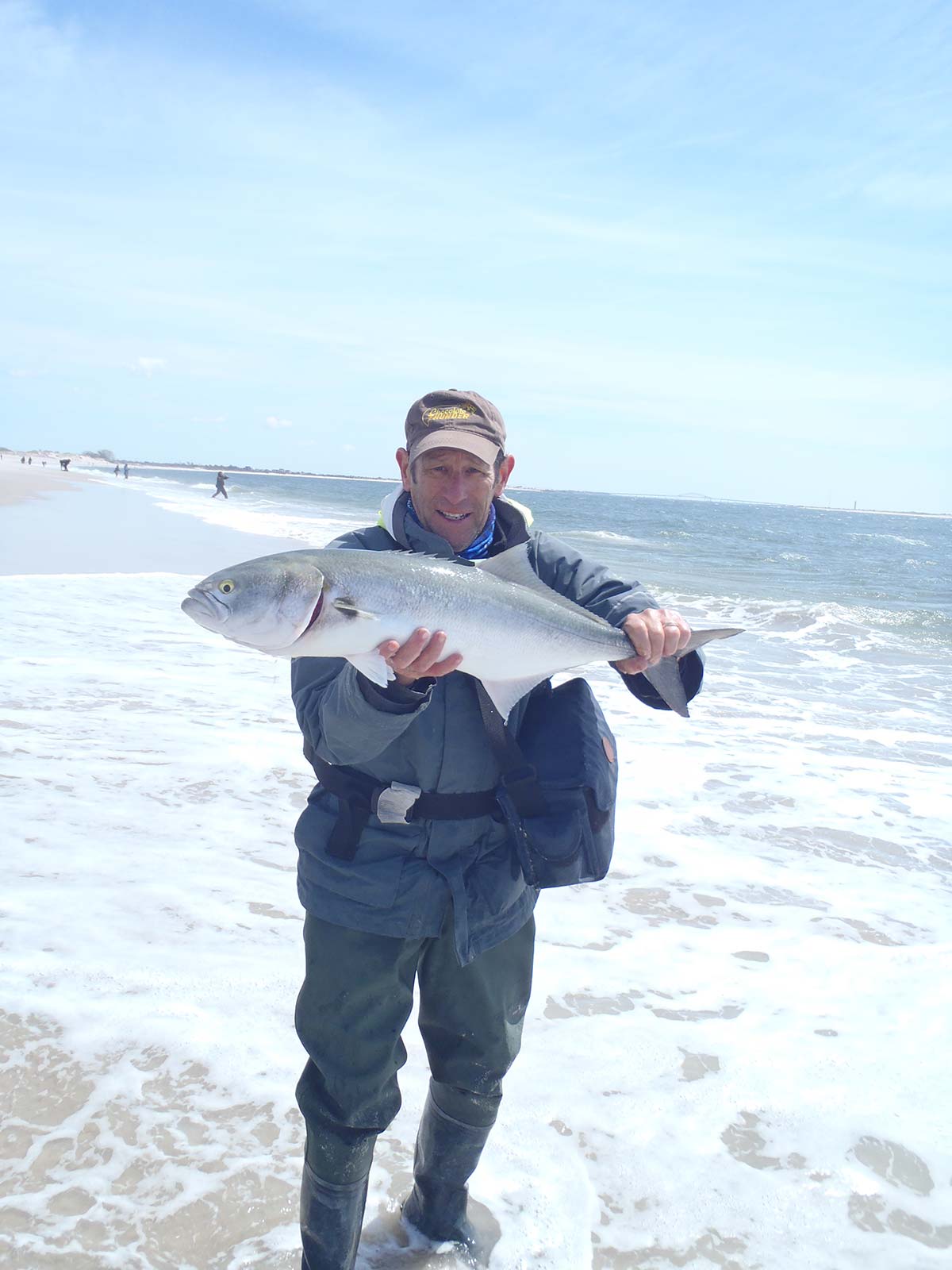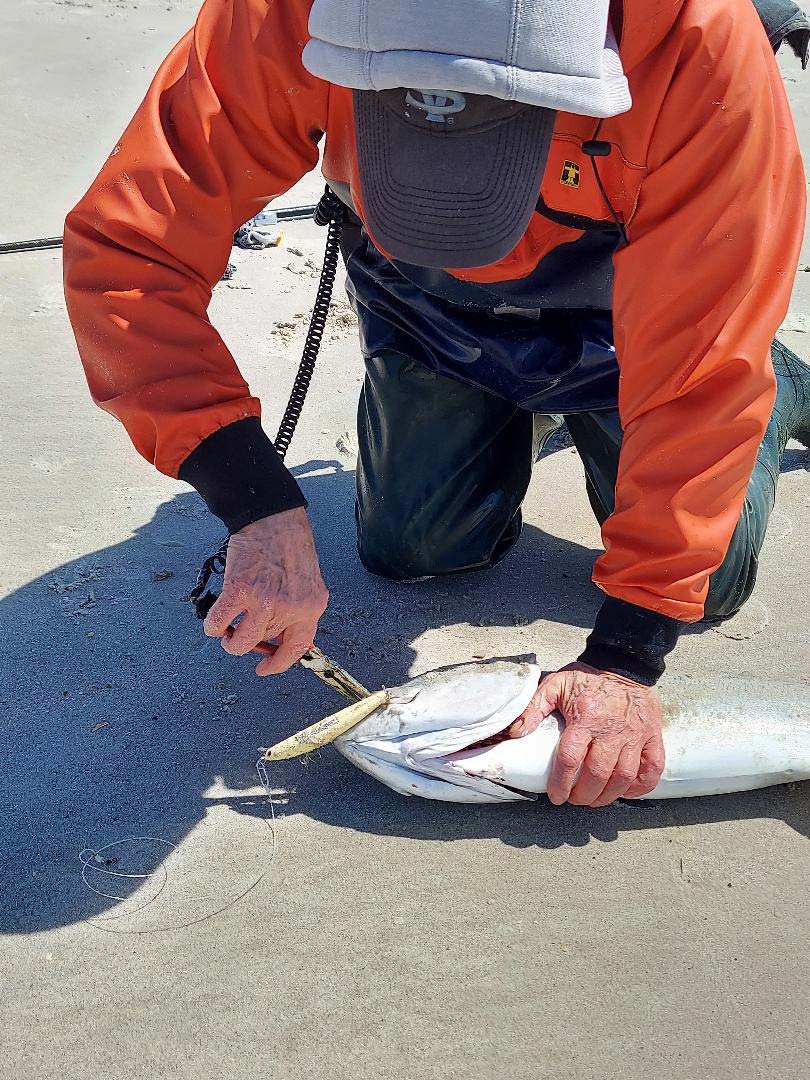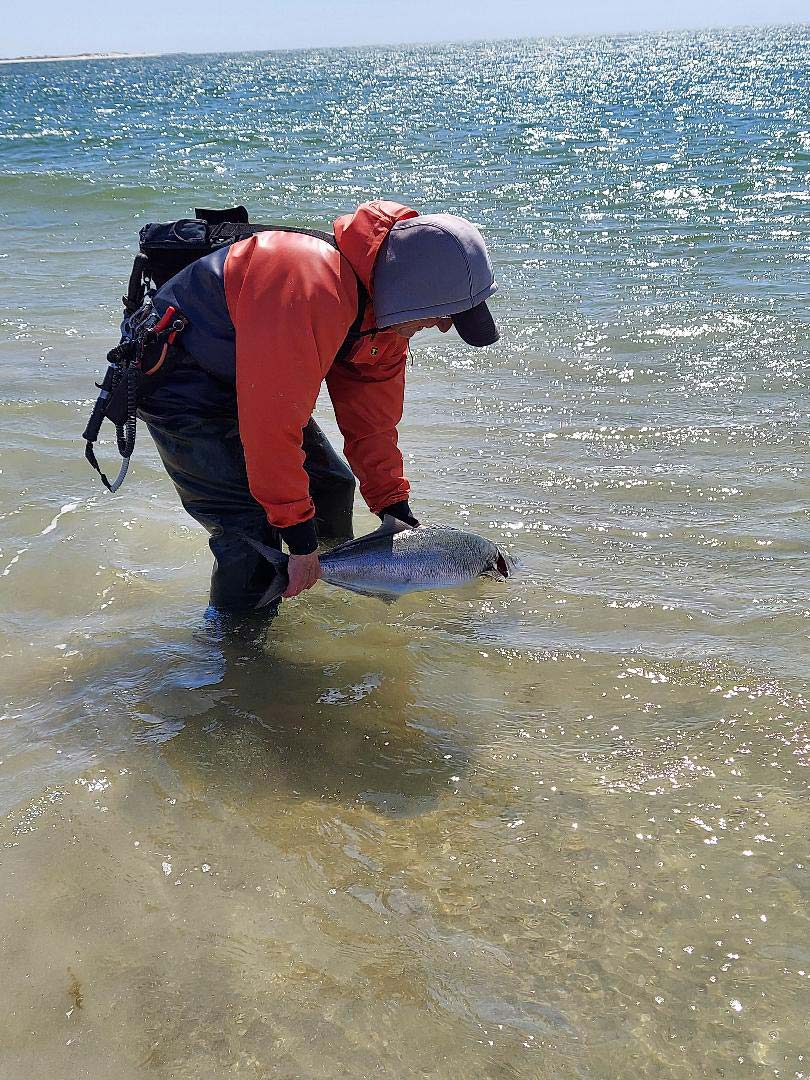
It’s no secret that bluefish are in decline, but good catches continue and this angler will state clearly that I love tussling with big bluefish. Thank goodness, there are still periods of hot fishing for bluefish available to both anglers in boats and those who trudge along the beaches. For those of you who are relatively new to saltwater fishing, big bluefish dominated fishing in the 1970s right through the 1990s, when we caught them from the beach in spring, summer, and fall but the decline of the population has meant we anglers need to sharpen our skills in order to enjoy better fishing.
A Smarter Approach
Where are we now? First of all, any species in decline will shrink away from spots at the edges of their range, even though they previously haunted them when the population was big. During periods of abundance, competition pushes fish to expand their range into areas they may not otherwise occupy. Second, in this case, bluefish are a pelagic species: that is, fish of the open ocean such as tuna and marlin. However, unlike billfish and tuna, bluefish are able to function in sounds, bays, and inner estuaries, such as harbors. Therefore, since migrating bait in the fall seems to be more abundant offshore than inshore in recent years, bluefish have remained mostly offshore as they migrated. Perhaps you’ve noticed immense flocks of gulls over blues way of the beach feeding near humpback whales, even though bait along the beaches has been generally sparse.
Why Is Spring Different?
On the other hand, the spring flurry happens because bait movements tend to be the opposite of those in autumn. So, where in the fall many species move west and then south without regard for depth, in the springtime bait is moving north and inshore. For example, adult mullet swim up-inlet to spawn in the bays, sand eels are moving shallow as the water warms, and squid are moving from the continental shelf into the inlets and bays to feed on sand eels, spearing, and anything else they can snare. That’s why we can enjoy spring bluefish flurries along the South Shore beaches.
Bluefish become involved in this inshore movement, too, as they travel from the western edge of the Gulf Stream where they spawn in April, towards shore as they follow the bait. Any post-spawn species tends to be ravenous because they don’t usually eat during the days when they spawn. A lot of energy is consumed both pre-spawn to make eggs and sperm, as well as during the intense activity of spawning. That’s why spring bluefish are often sunken-bellied and narrow across the back in May, and why many anglers call spring blues “racers.” Sometimes, a blue is thick and heavy because it didn’t spawn (not every fish will spawn every year), but most are thinner than in the fall. Now, because they are ravenous, they feed with abandon and when feeding along a beach, they can be very easy to catch. The problem is, in today’s spring flurries, the action can be intermittent, and many of the fish caught are smaller than in decades past.
I can tell those of you who are new to all this that in the last decades of the 20th Century the typical big blue caught was 12 to 14 pounds, and no one even bothered to pick their head up to look at a blue unless it was 17 pounds. Today, our standards have fallen a bit. I frequently hear an angler refer to an 8-pound blue as big. Nice fish for sure, and a feisty fighter, but to those of us who caught them in the 1980s, this is a medium-sized bluefish. Don’t get me wrong, there are still some truly big ones around—two blues I caught last year that weighed 15 and 16 pounds, but the age structure has changed in recent years. If recruitment is low and harvests high, then fewer fish reach their next year and, over time, there are fewer old and ornery specimens. But in the mid-20th Century, there were so many consecutive fantastic year classes of bluefish that there was no way the harvests could keep up, and we enjoyed fishing on vast schools of truly monster bluefish.

Making The Most Of It
Still, spring flurries continue in the inlets and the beaches adjacent to the inlets, and sometimes even in the bays. Since year classes continue to come up short, and since people seem to continue to be intent on harvesting them with enthusiasm, it’s difficult to predict future fishing.
We can, however, prepare better in anticipation of the spring flurries.
Most fishermen understand the difference between fishing and catching. True beach rats are sportsmen, and work the beaches in spring relentlessly. Although they may not catch every day, their persistence and perseverance are eventually rewarded. Many have been releasing most of the blues they catch because they are experienced and appreciate the need for conservation.
Then, there’s the problem of how to fish for them. During the height of past runs, we weren’t particularly fussy about the lures we used because feeding competition was so intense. However, in recent years I’ve found that many favorite lures of the past aren’t as effective, and lures I never used seem to be working better. For example, tins with tubes, poppers, and bucktails were most productive, but recently tins with tubes have definitely not been as effective for the larger blues. Bucktails continue to work well on most days as do poppers and pencil poppers, but there have been days and times in the tide when even these “old reliable” lures just weren’t as good as others. On these occasions I switched to 5-inch SP Minnows and Mag Darters. The first thing that was unusual about this was these lures are normally used at night, but we used them in the day. The second surprise was that most often the best retrieve was a very slow one (like a night retrieve), and without twitching. Typically, blues did not smash these lures, instead, I’d feel a bump and then weight. I found that if I didn’t react immediately to a light bump and instead waited for weight on the line before setting the hook, I got more solid hook-ups.
The Changing Tides
One of the things I enjoy about fishing is that it’s rarely the same from tide-to-tide, day-to-day, or year-to-year. Therefore, we need to observe and adjust constantly. I’ve observed many anglers fishing in the surf over my fishing decades, and I’ve noticed that many throw the same lures and make the same retrieve regardless of the type of bait, the water conditions, the weather conditions, or the moods of the fish. I call this robotic fishing and it robs an angler of the joys of solving the angling puzzle, appreciating how fishing changes, developing a better understanding of the fish they chase and, most important of all, reduces their success. If conditions and fishing were the same on every trip, I’d tire of it quickly. You see, my legs still shake and my blood pressure still rises as I drive to a spot anticipating the experience, and that’s because it’s never the same and therefore always exciting. Should fish and fishing become very predictable, I’ll stop fishing.
Absorb Information
Amazingly, most anglers don’t even realize they are approaching fishing in a linear manner. As I mentor fishermen in the sport, I’ve often had this experience. I’ll say, “Take a look around, evaluate the conditions, take in the information, interpret the type of hits you’ve had, and then adjust your lures and your retrieves. You’re doing the same thing over and over, without regard to the changes occurring around you.” Often, they’ll respond emphatically, “I’m not doing that.” Interesting how psychological resistance limits many an angler. I guess they figure that my 70 years of surf fishing just doesn’t count for much.
Even during a blitz anglers may need to adapt for several reasons: the water level has changed, the bait has been harassed or dispersed, and the wind may shift, etc. Why should we think that fish and conditions are the same all the time? That makes no sense. If conditions change, why wouldn’t we think that fish behavior will change, too? A continuation of this logic line then suggests that fishermen who adjust make the most of the potential fishing.

Adapt And Adjust
In order to be able to adjust and adapt requires three things from an angler. One, have an open mind and don’t fish robotically. Second observe your surroundings carefully. Third, pay attention to what the fish are “saying.” Of course, they don’t speak in words, but their behaviors will tell you a lot about what’s changing below the surface and how the fish are adjusting their behavior. You don’t have to speak fish; you just have to listen.
I can’t give you a checklist to follow because fish behavior is very flexible because they are instinctive and not intellectual. However, if you pay attention, there will be subtle indications that things have changed, and at that point an angler should begin the process of adjusting lures, retrieves, and casts. However, be aware that no two events are the same. Now, let’ see how this connects to spring surf fishing for bluefish. I suggest an angler spend less time worrying about lure color, be less committed to a love for surface smashes, change a retrieve before changing a lure, gather information from the surroundings, and concentrate on figuring out the mood of the fish.
My Game Plan
I always start with a bucktail because I can make a greater variety of presentations than I can with any other lure. Now, I pay attention! If there is any hint to suggest a change in fish behavior, I will begin to alter my presentation or lure. Although experience helps an angler select a more likely successful starting point, the process is nonetheless trial and error.
At this point, I must point out that although I carry perhaps six different styles of lure, my color palette is limited—basically white. I’m amazed by the anguish over color, instead of thinking about which lures and presentations best match the situation. I always make at least 10 casts with a given lure and presentation before moving on to another. Yet, I watch as some surf rats make one cast and change the lure, and repeat this over and over. What evidence is gained with one or two casts? None!
Finish The Retrieve
I also watch retrieves when anglers change lures frequently. I notice their presentation is off because, lacking confidence in a lure, they hurry the retrieve and don’t finish the retrieve to their feet. Perhaps surprisingly, anglers are not usually aware of this. It is important to focus on every cast and every retrieve because with a smaller population, fish have more time to notice what doesn’t seem to be quite right and they shy off the attack. Every cast is precious, so make them count. With an eye toward being flexible, making sound evaluations of conditions, and a focus that makes your efforts count, we can enjoy those spring flurries of blues.



